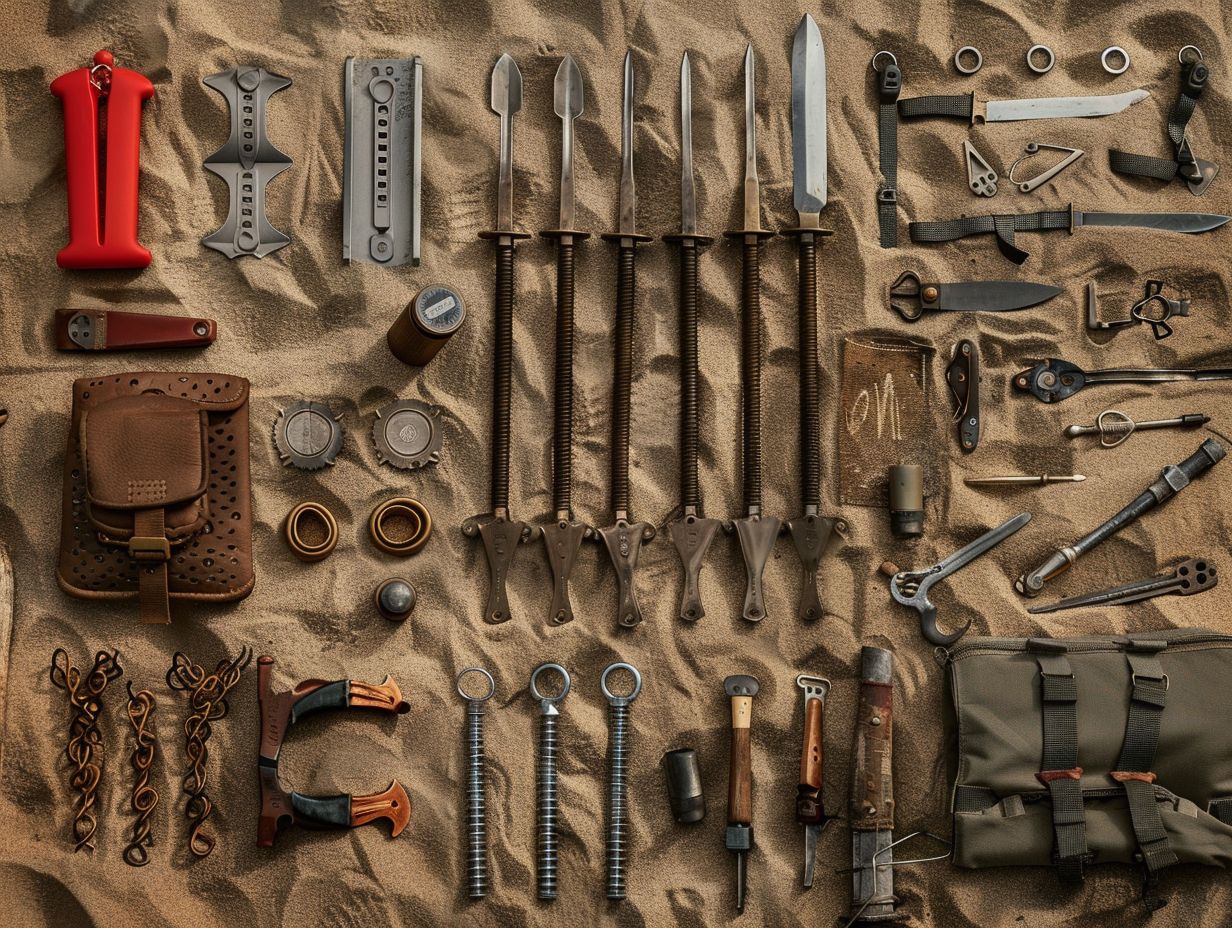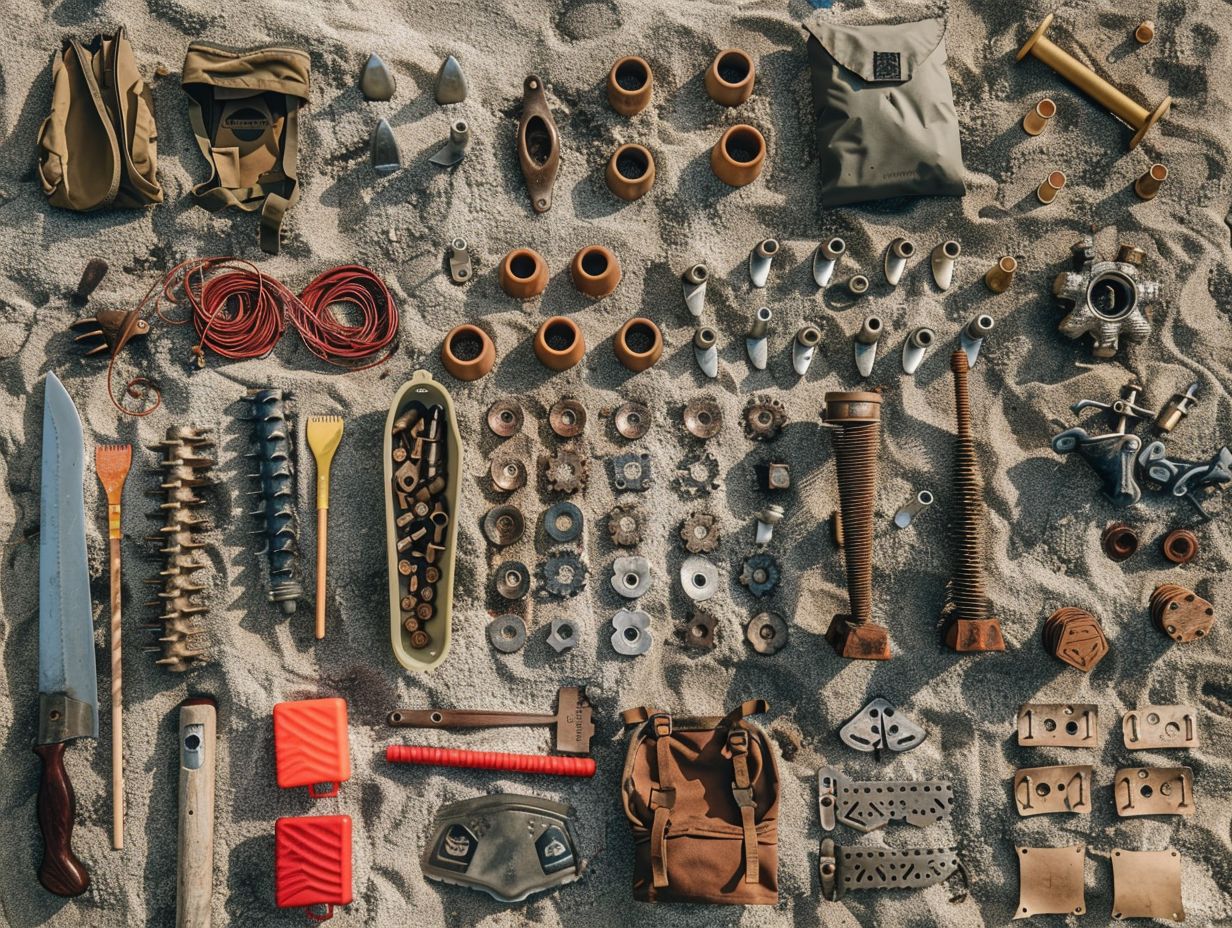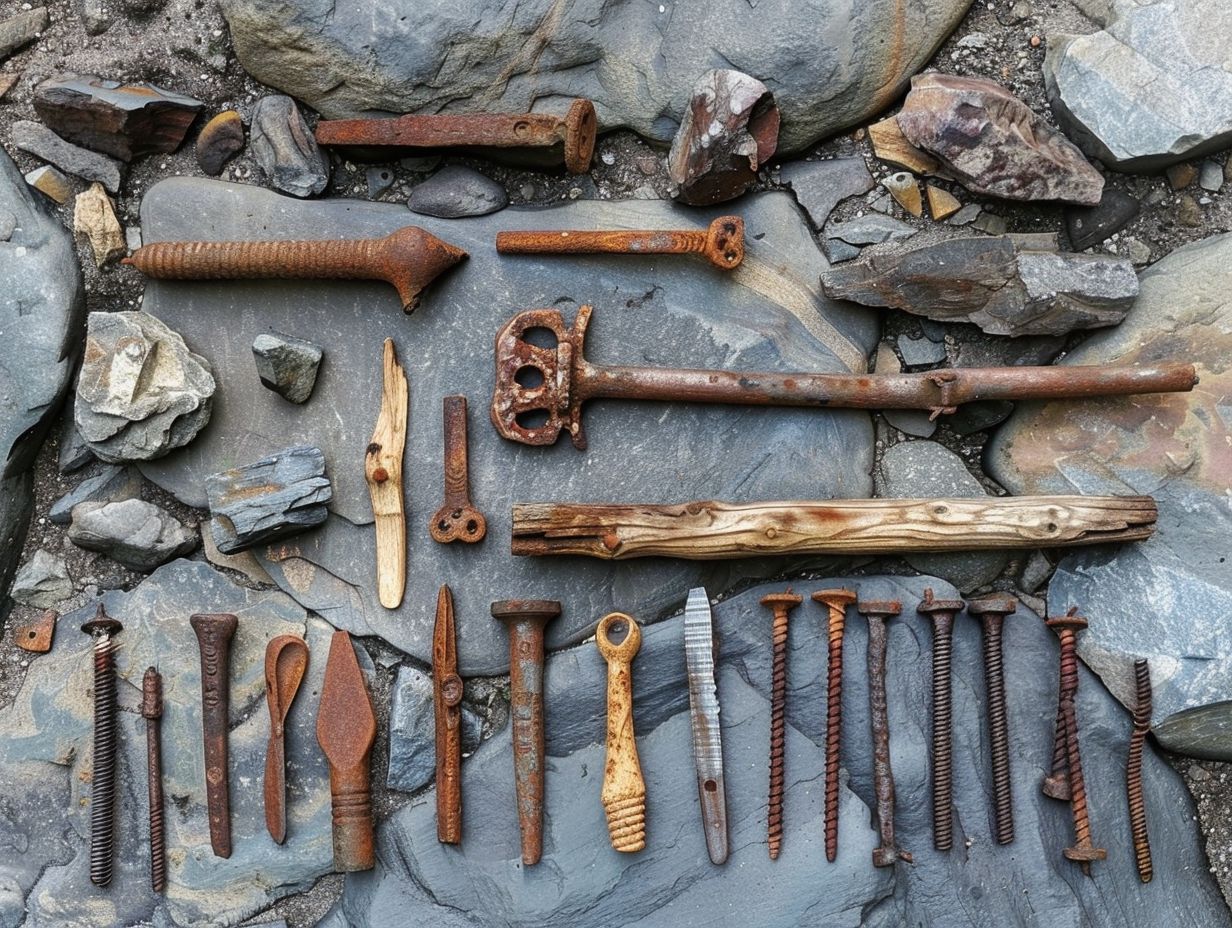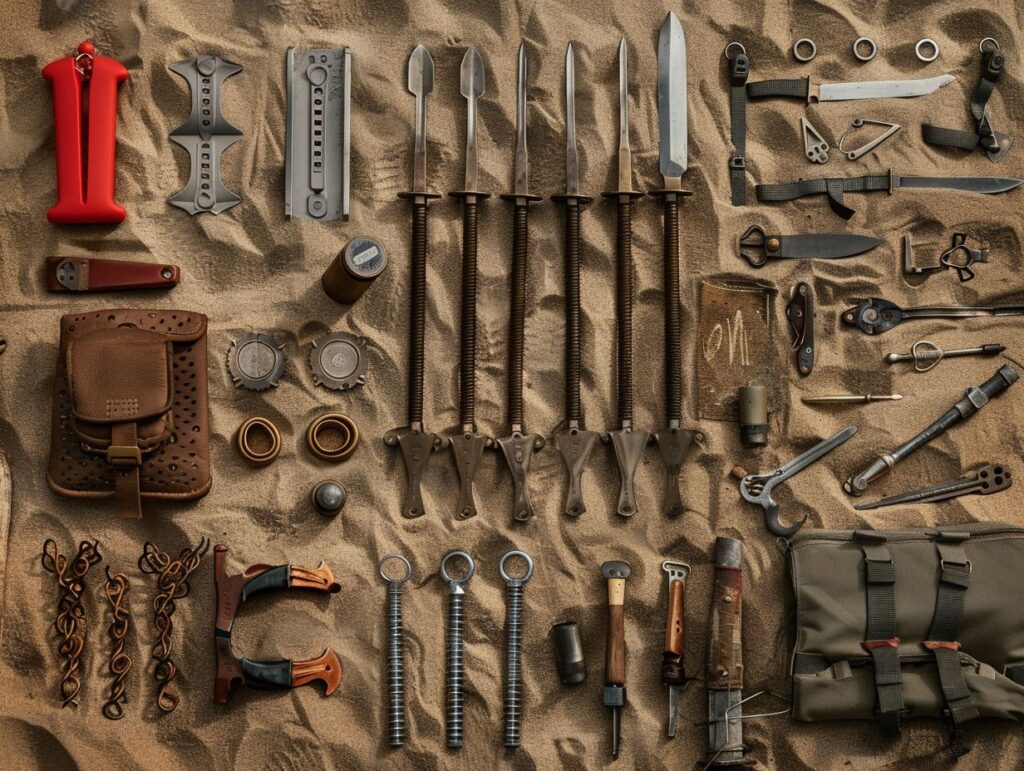Setting up a tent requires choosing the right tent pegs for a successful camping experience. Different pegs are designed for various terrains and weather conditions.
Steel, aluminium, plastic, and titanium pegs each have their own advantages. Consider factors like terrain, weather, tent weight, and durability when selecting pegs.
Explore the types of tent pegs, tips for using them on different terrains, common mistakes to avoid, and proper maintenance and storage.
Ensure your tent is securely anchored wherever your adventures may lead!
Key Takeaways:

- Consider the terrain before choosing tent pegs to ensure stability and durability.
- Use appropriate tent pegs for the weather conditions to prevent damage and ensure a secure tent setup.
- Check for rocks or obstacles before securing tent pegs to avoid damage and ensure a safe camping experience.
What Factors Should You Consider When Choosing Tent Pegs?
Selecting the appropriate tent pegs necessitates the consideration of several crucial factors, including the terrain, weather conditions, tent dimensions, durability, and user-friendliness. This ensures that your camping expedition is both secure and comfortable.
1. Terrain

The selection of tent pegs is contingent upon the type of terrain on which camping will take place.
- For soft terrains such as sandy beaches or loamy soil, longer pegs like sand or spiral stakes are recommended due to their superior grip. These pegs are effective in preventing the tent from being dislodged by strong winds or shifting sands.
- In rocky terrain, heavy-duty pegs like Y-pegs or rock pegs are preferable as they provide stability in harder ground.
- In snowy or winter conditions, snow stakes or snow anchors are critical for securing the tent in icy or snowy surfaces, ensuring a safe and stable shelter.
2. Weather Conditions
Weather conditions are a critical factor to consider when selecting appropriate tent pegs, as various materials and designs exhibit superior performance in specific weather conditions.
For example, when dealing with rainy conditions, it is crucial to choose tent pegs with robust construction to ensure they remain securely anchored in the moist ground. Likewise, in the presence of strong winds, pegs featuring a firm grip or spiral designs can help prevent the tent from being displaced.
In snowy environments, longer pegs crafted from durable materials such as aluminium or titanium are recommended for penetrating frozen surfaces. It is essential to anticipate potential weather conditions and choose pegs that can offer stability and protection for your shelter effectively.
3. Tent Weight and Size
The weight and size of a tent are critical factors to consider when choosing ground anchors to ensure stability and security. In instances where the tent is heavier and larger, it will necessitate more robust and sturdy tent pegs to withstand windy conditions. Conversely, lighter and smaller tents may be better suited to lightweight aluminium or titanium pegs.
Family tents of larger sizes generally benefit from steel or heavy-duty plastic pegs for improved anchoring, while ultralight backpacking tents can leverage specialised stakes such as Y-shaped or V-shaped pegs for weight efficiency. It is imperative to align the tent pegs with the specific requirements of the tent to enhance its performance across varying weather conditions and terrains.
4. Durability
The consideration of durability is paramount in assessing the longevity and reliability of tent pegs. When examining the durability of tent pegs, the choice of materials assumes a critical importance. Steel tent pegs are renowned for their robustness and durability, rendering them well-suited for challenging terrains.
Conversely, aluminium pegs, while lightweight, are susceptible to bending when encountering hard ground.
To extend the lifespan of tent pegs, it is advisable to clean and thoroughly dry them after each use to mitigate the risk of corrosion. Proper storage in a dry location is essential, and regular inspection for any indications of wear or damage is recommended prior to embarking on your next camping excursion.
5. Ease of Use
The ease of use, encompassing aspects such as the simplicity of driving and extracting tent pegs, plays a crucial role in facilitating a seamless camping experience.
When considering the different types of tent pegs available, it is important to note that the level of user-friendliness can vary significantly. For example, conventional steel pegs may necessitate more force for insertion into the ground as opposed to their lightweight aluminium or plastic counterparts.
Selecting pegs equipped with a firm grip or ergonomic handles can greatly enhance the process of both insertion and extraction. It is advisable to choose pegs featuring hook-shaped tops or ribbed designs, as these configurations offer superior anchorage and stability across diverse terrains, thereby ensuring the stability of your tent in adverse weather conditions.
What Are Some Tips for Using Tent Pegs on Different Terrains?
Effectively utilising tent pegs across various terrains necessitates a comprehensive comprehension of the distinct challenges present and a judicious selection of the appropriate peg types to guarantee optimal stability and security.
1. Rocky Terrain
When camping on rocky terrain, it is crucial to utilise rock tent pegs specifically designed to penetrate hard surfaces effectively. These specialised tent pegs are typically constructed from durable materials such as aluminium or titanium, providing the necessary strength to endure challenging conditions.
To ensure a stable setup in rocky terrain, it is essential to angle the pegs slightly towards the direction of the tent’s pull. This strategic positioning enhances grip and stability by minimising the likelihood of the pegs slipping out. For additional support, it is advisable to employ a mallet or hammer with a flat striking surface to securely drive the pegs into the ground.
By adhering to these techniques, campers can enjoy a worry-free camping experience even when facing the most rugged terrains.
2. Sandy Terrain

Screw tent pegs are an optimal choice for sandy terrain due to their enhanced grip and stability in loose soil. The corkscrew-like design of these pegs enables them to spiral deeply into the sand, establishing a robust anchor that is less susceptible to displacement by wind or movement.
When inserting screw tent pegs, it is imperative to exert downward pressure while rotating them clockwise to ensure effective penetration and secure grip within the sand.
To further bolster their stability, it is advisable to position the pegs slightly angled towards the anticipated direction of force, such as the prevailing wind. Regular monitoring and adjustment of the pegs, as necessary, can aid in sustaining their grip amidst the shifting sand.
3. Soft Ground
In instances of soft ground, the utilisation of plastic tent pegs can prove to be effective, primarily due to their expanded surface area, which facilitates the uniform distribution of weight.
Furthermore, an additional advantage of employing plastic tent pegs in soft ground lies in their lightweight composition, rendering them easily transportable and manageable.
When positioning plastic pegs, it is advisable to insert them with a slight angle away from the tent to optimise their grip. For increased stability, the consideration of supplementary support through guylines or the interconnection of multiple pegs to bolster strength is recommended.
By strategically integrating plastic tent pegs into soft ground settings, campers can revel in a secure and dependable arrangement for their outdoor escapades.
4. Snowy Terrain
Delta pegs are an ideal choice for use in snowy terrain due to their ability to provide a secure grip in snow and ice. Their distinctive design, characterised by a broad surface area and sturdy construction, guarantees their capacity to penetrate frozen ground effortlessly, delivering stability in challenging winter conditions.
To optimise their performance in winter camping scenarios set in snow-covered landscapes, it is recommended to position the pegs at an incline to enhance their traction, as opposed to hammering them directly downward.
Employing a resolute and consistent approach when securing them into the ground, and ensuring thorough anchoring, are essential measures to prevent slippage or dislodgement caused by frost heaving or strong winds.
What Are Some Common Mistakes When Using Tent Pegs?
- When setting up tent pegs, campers often make common mistakes, such as:
- Not using pegs adequately
- Improperly securing the tent
- Choosing unsuitable types of tent pegs
- Failing to check for rocks or obstacles
1. Not Using Enough Tent Pegs
Failure to use a sufficient number of tent pegs relative to the size of the tent may result in instability and potential collapse, particularly in adverse weather conditions.
It is imperative to ensure adequate reinforcement by employing an appropriate quantity of tent pegs corresponding to the dimensions of the tent. For larger tents, such as those designed for family or camping group use, it is advisable to utilise at least one peg for each corner with additional pegs positioned along the sides to enhance structural stability.
Properly securing the tent involves driving the pegs into the ground at a 45-degree angle away from the tent to establish a firm anchorage. By tightening the guy lines connected to the pegs, additional stabilisation is achieved, fortifying the tent against strong winds and severe weather conditions.
2. Not Securing the Tent Properly
The proper anchoring of the tent with ground anchors is essential to prevent its displacement or collapse in adverse weather conditions. One effective method to ensure the secure anchoring of the tent involves driving the pegs into the ground at a 45-degree angle away from the tent.
This specific angle provides optimal resistance against lateral forces that could potentially dislodge the pegs. It is imperative to embed the pegs sufficiently deep into the ground to guarantee stability. A minimum depth of 6-8 inches is generally recommended, as pegs that are anchored shallowly are more susceptible to being extracted by strong winds or ground motion.
3. Using the Wrong Type of Tent Pegs
Using inappropriate tent pegs that are not suited to the terrain or weather conditions can result in inadequate stability and potential damage to the tent.
In sandy or loose soil, traditional steel pegs may struggle to securely anchor, resulting in an unstable tent configuration. In such circumstances, selecting longer, spiral-shaped pegs or sand pegs with an increased surface area can offer improved grip and stability.
Conversely, rocky terrain requires the use of durable rock pegs crafted from aluminium or titanium to effectively penetrate tough surfaces. Snowy conditions require the deployment of snow stakes or snow anchors specifically engineered to provide secure anchoring in icy or snowy ground.
Aligning the choice of pegs with the environmental conditions enhances the safety and durability of the camping shelter.
4. Not Checking for Rocks or Obstacles

Failure to conduct a preliminary check for rocks or obstacles before placing tent pegs can result in the bending or breakage of the pegs, leading to challenges in adequately securing the tent.
An advantageous recommendation involves a comprehensive examination of the ground where the tent is intended to be erected. It is advisable to search for any rocks, roots, or other obstructions that may impede the proper insertion of the pegs.
By clearing the designated area and selecting a location with a smooth and obstruction-free surface, potential damage to the tent pegs can be prevented.
During the placement of the pegs, it is essential to position them at a slight angle away from the tent and towards the anticipated direction of tension. This alignment aids in securely anchoring the tent while reducing the likelihood of pegs bending or breaking.
How Do You Maintain and Store Tent Pegs?
Proper maintenance and storage of tent pegs are crucial to ensure their longevity and efficiency during upcoming camping expeditions.
To properly clean tent pegs, it is recommended to start by removing any dirt or debris that may be lodged in the grooves and crevices using a brush or an old toothbrush.
A thorough inspection of each peg should be carried out to check for any signs of rust or damage, such as bent tips or cracks. If any issues are identified, it is advisable to consider repairing or replacing the affected pegs to prevent any unexpected incidents during future outdoor activities.
For prolonged storage periods, it is advisable to store tent pegs in a dry and well-ventilated place to prevent the build-up of moisture, which could cause corrosion. Some experienced campers suggest using a designated peg bag or container to maintain organization and make access easier when needed.
Frequently Asked Questions
1. What are the key factors to consider when choosing tent pegs for different terrains?
The key factors to consider are the type of terrain you will be camping on, the weight and size of your tent, and the weather conditions you may encounter.
2. Are there different types of tent pegs for different terrains?
Yes, there are different types of tent pegs designed specifically for different terrains such as rocky, sandy, or soft soil. It is important to choose the right type to ensure stability and secure anchoring of your tent.
3. What type of tent pegs should I use for rocky terrains?
For rocky terrains, it is recommended to use heavy-duty metal tent pegs such as aluminum or titanium. These pegs are strong enough to withstand the pressure and provide a secure hold on rocky surfaces.
4. Can I use the same tent pegs for different terrains?
It is not recommended to use the same tent pegs for different terrains as they may not provide enough stability or may get damaged easily. It is best to invest in a variety of tent pegs suitable for different terrains to ensure a safe and enjoyable camping experience.
5. Are there specific tent pegs for windy conditions?
Yes, there are specific tent pegs designed for windy conditions. These are usually longer and have a spiral or corkscrew shape to provide a stronger hold in the ground. It is important to use these pegs in windy conditions to prevent your tent from being blown away.
6. Can I use plastic tent pegs for all terrains?
No, plastic tent pegs are not suitable for all terrains. They are best for soft or sandy soils where they can easily be pushed into the ground. In rocky or hard terrains, they may break or bend easily, compromising the stability of your tent.

